Category Archives: Injury Prevention
Too Often The Urgency To Get Fit Quick Leads To Poor Results And Injury
“By your mid-30s, most people still look young, but are already experiencing the BIG Three of aging: deteriorating lean muscle mass, worsening posture, and crumbling joints” say Robert Forster, Physical Therapist and PT. His practice in Santa Monica is the unofficial meeting hall for broken -down triathletes, advernture racers and gym rats!
“Age related decline hits sooner than you think”
“Too often however, the urgency to get fit quick leads to poor results and injury as we try to play catch up with overzealous workouts and ill-advised dieting. The most common mistake is to turn to the unscientific, but none the less popular, “all out” workouts like Cross Fit and P90X to make up for lost time. These programs often lead to injury, burnout and rebound weight gain.”
The value of Phase 1 of the 24 Fit Workout, developed by Robert Forster
Phase 1 is about establishing stability throughout every part of your body. Thats Spine and Pelvic Stabilization, Shoulder Stabilization and Total Body Integration. This involves the use of light weights and other exercises to strengthen all the little “helper muscles” around the joints, which, along with a lot of stretching insures that each joint is functioning properly. This phase prepares the body for the more strenuous work to come later in the training cycle. What Robert Forster calls making his runners “bullet proof” or “Kevlar Training” so that they don’t breakdown during training. He has worked with beginners and elite Olympic athletes.
By the time you’ve completed Phase 1, you’ll not only have improved posture and joint health, but your body will also be properly prepared for the strength and power workouts to come in Phases 2 and 3.
Our goal is to get you race-ready or match-ready without becoming mentally frustrated, physically tired or, even worse, injured.
Related – High Intensity Workouts Can Lead to Injuries/

High Intensity Workout Programs That Can Lead to Injuries
Problem: The P90X workout is one of the biggest fitness trends in the past several years, with enthusiastic endorsements across the cultural spectrum, including everyone from singer Pink to 2012 Republican vice presidential nominee Paul Ryan.
But businessman Matt Lombardi says just one day of the program’s strenuous routine sent him into the emergency room.
Lombardi says he has “always been an athlete” and that he didn’t wander recklessly into the program. Instead, he says he wanted to try P90X to help lose the 20 pounds he had gained while developing College Spun. Read More here And watch video here.
The above article references what our physical therapists see all day. You can try to figure out what program will work for you and hope that you do not get injured or you can rely on a time tested and proven program that is safe and effective.
Solution: After a careful review of the P90X workout when it first came out we predicted a plethora of overuse and traumatic injuries. Since then I have had to explain to the many clients injured from these high intensity, ill designed training programs that not even my Olympians would hold up under the stress of these workouts. The creators of this training program were apparently not alive during the 1980’s when Jane Fonda type workouts caused an epidemic of joint and muscle injuries from jumping and running on hard surfaces and `performing body weight exercises with no regard for form and technique.
Whats a better approach to working out?
The basic premise of all well designed exercise programs is the progressive overload principle. Fitness must be “pushed” from below, i.e. starting slow and progressing to harder workouts slowly. In addition, what recreational athletes and fitness enthusiasts don’t realize is that elite and professional athletes spend half of their workout time in the gym on injury prevention. All strength and conditioning programs must begin with a joint stability phase where the body is hardened against injury. This involves the use of light weights and other exercises to strengthen all the little “helper muscles” around the joints, which, along with a lot of stretching insures that each joint is functioning properly. This phase prepares the body for the more strenuous work to come later in the training cycle.
Secondly, no one can withstand high intensity training for more than a period eight weeks. Even if one was to avoid injury with this type of workout, in about 8 weeks the body will adapt to a certain level stress and as fitness plateaus continued training at the same intensity will cause burnout, injury or both. Conversely, the way we train elite athletes to win gold medals and set world records is with a periodization training program rooted in science and built specifically to avoid over training and prevent injury. This involves breaking the training cycle into phases and training for a specific fitness attribute for no more than 8 weeks and as the body adapts changing the training stimulus to foster further improvements. This is the key to achieving and injury free peak fitness.
At Phase IV our strength and flexibility programs are designed by physical therapists with over thirty years of experience helping athletes of all ages and abilities achieve their goals, injury free. Following a head to toe Structural Exam a personalized strength and conditioning program will be designed to meet your needs whether you want to train with us, at your gym or at home.
Strength Training For Endurance Athletes
April 11th – Line from my lecture this weekend at the Boston Marathon: “Runners can either strength train, or they can rehab.”
Tom Holland is an elite endurance athlete and physiologist committed to helping people live a better life through fitness. Tom has run over 50 marathons, is a 19-time Ironman® triathlete.

“Done properly, strength training for the endurance athlete is in many ways the quickest way to achieve the structural goals of the Base Training Phase of triathlon training: Joint Stability and Musculoskeletal Resiliency. Using light weights and rubber band exercises which isolate the small muscles around each joint will not only help prevent injury but will directly improve performance throughout the season. If you were to do nothing more than the low-intensity strength work of early season training the payoff in developing musculoskeletal resiliency and biomechanic efficiency will benefit you all year. ” Robert Forster
Physical Therapist and Performance Specialist Robert Forster developed the Herbalife24FIT program with Herbalife. He is one of the leading physical therapists for athletes, both recreational and elite. Over the course of his 30-year career, he has successfully trained Olympic gold medalists, U.S. Open and Wimbledon champions, NBA superstars and triathlon world-record holders. Tired of encountering ill-advised training programs that only cause more injury, Robert created a new approach to physical therapy, which is divided into phases that follow the body’s natural healing and growth patterns. His practice in Santa Monica, California, provides athletes with effective, scientific and injury-free solutions for health and performance.
How to Use The 24 Fit Programme – On Alternate days i.e. Monday, Wednesday, Friday. Use with light weights and resistance bands.
Additional Information:


